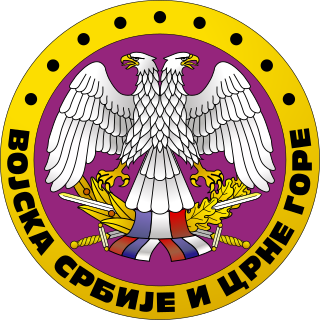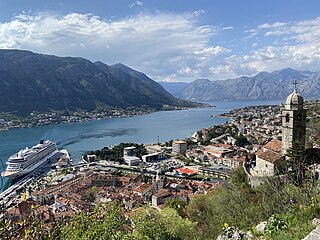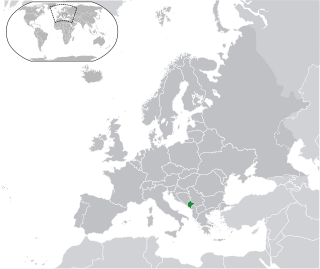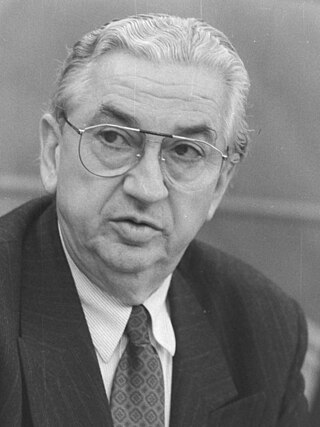
Montenegro is a country in Southeastern Europe, on the Balkan Peninsula. Its 25 municipalities have a total population of 633,158 people in an area of 13,812 km2. It is bordered by Bosnia and Herzegovina to the northwest, Serbia to the northeast, Kosovo to the east, Albania to the southeast, Croatia to the west, and has a coastline along the Adriatic Sea to the southwest. The capital and largest city is Podgorica, while Cetinje is the Old Royal Capital and cultural centre.

The Armed Forces of Serbia and Montenegro included ground forces with internal and border troops, naval forces, air and air defense forces, and civil defense. From 1992 to 2003, the VSCG was called the Yugoslav Army, created from the remnants of the Yugoslav People's Army (JNA), the military of SFR Yugoslavia. The rump state, then named Federal Republic of Yugoslavia, participated in the Yugoslav Wars with limited direct intervention of its own armed forces. Following the end of the Wars and the constitutional reforms of 2003 by which the state was renamed "Serbia and Montenegro", the military accordingly changed its name. The military was heavily involved in combating Albanian separatists during the Kosovo War and Preševo Valley conflict, and also engaged NATO warplanes during the 1999 NATO bombing of Yugoslavia.

Podgorica is the capital and largest city of Montenegro. The city is just north of Lake Skadar and close to coastal destinations on the Adriatic Sea. Historically, it was Podgorica's position at the confluence of the Ribnica and Morača rivers and at the meeting-point of the fertile Zeta Plain and Bjelopavlići Valley that encouraged settlement. The surrounding landscape is predominantly mountainous terrain.
The early written records of the history of Montenegro begin with Illyria and its various kingdoms until the Roman Republic incorporated the region into the province of Illyricum after the Illyro-Roman Wars.

Kotor, historically known as Cattaro, is a town in Coastal region of Montenegro. It is located in a secluded part of the Bay of Kotor. The city has a population of 13,347 and is the administrative center of Kotor Municipality.

HELLENiQ ENERGY Holdings S.A., formerly known as Hellenic Petroleum S.A., is one of the largest oil companies in Southeast Europe and with its roots dating to 1958 with the establishment of the first oil refinery in Aspropyrgos, Greece.

The Zeta Banovina, was a province (banovina) of the Kingdom of Yugoslavia between 1929 and 1941. This province consisted of all of present-day Montenegro as well as adjacent parts of Central Serbia, Croatia, Kosovo and Bosnia and Herzegovina. It was named after the Zeta River which also gave its name to the medieval state of Zeta that roughly corresponds to modern-day Montenegro. The capital of Banovina was Cetinje.

The University of Montenegro is a national public university of Montenegro.

The culture of Montenegro is as pluralistic and diverse as its history and geographical position would suggest. Montenegro's culture has been influenced by the Serbian Empire, the Byzantine Empire, ancient Greece, ancient Rome, Christianity, the Ottoman Empire, the Republic of Venice, Austria-Hungary, and Yugoslavia.
Sport in Montenegro revolves mostly around team sports, such as football, basketball, handball, and volleyball. Other sports involved are boxing, tennis, swimming, judo, karate, athletics, table tennis, and chess.
Montenegro was independent from the Late Middle Ages until 1918, when it declared its union with Serbia and, subsequently, became part of various incarnations of Yugoslavia and the state union of Serbia and Montenegro. During this time, football in Montenegro was part of the wider Yugoslavian structures. As a result of the Montenegrin independence referendum held on May 21, 2006, Montenegro declared independence two weeks later, on June 3, and formed its own football association.

The history of the Jews of Montenegro dates back to the times when that area was connected to the division of the Roman Empire between Roman and Byzantine rule. Since modern-day Montenegro is a young country the Jewish community of Montenegro is the youngest and one of the smallest Jewish communities in the world. The decision on forming a formal community was made in June 2011 at the home of Mrs. Đina Lazar in Herceg Novi. At the end of July of the same year, the community was registered as a citizens' association and thus gained certain legal legitimacy. Very soon after registering, the Chief Rabbi of Israel Rabbi Yona Metzger visited Montenegro and the Jewish community. Rabbi Metzger, along with escorts and leading members of the community, was received by the most important state officials: the Presidents of the State, the Parliament and the Government.
Societe Generale bank Montenegro was a bank operating in Montenegro. Founded in 1906 as Podgorička banka, it offered services in corporate and retail banking. The bank provides a range of depository and lending services, which include checking accounts, savings accounts, money market accounts, commercial loans, consumer loans and construction, mortgage loans, safety deposit boxes, VISA credit cards, Western Union services and an ATM network.
Petrol Group is a Slovenian oil distributing company, which is one of the largest in Slovenia and the former Yugoslavia and controls 500 petrol stations, of which there are:

Dragan Tomić was a Serbian politician who served as the president of the National Assembly of Serbia from 1994 to 2001. He was a member of the Socialist Party of Serbia and was considered a loyal supporter of Slobodan Milošević. Tomić was director of RTV Politika, one of Serbia's main TV stations, and director of Jugopetrol AD, the state oil company.

Foreign relations between Croatia and Montenegro are bound together by shared history, intellectual development, and common geography. Both states are members of the Council of Europe and NATO. Montenegro has been a candidate to join the European Union since 2012, a pursuit supported by Croatia, who has been an EU member since 2013. Their diplomatic relations have been friendly and amicable, with strong political and economic collaboration. Small border disputes have remained unresolved between the two states since the dissolution of Yugoslavia, as do some shipping and naval disagreements.
The 1979 Montenegro earthquake occurred on 15 April at 06:19 UTC with a moment magnitude of 6.9 and a maximum Mercalli intensity of X (Extreme). It was the most devastating earthquake in SR Montenegro, then part of Yugoslavia, and was mostly felt along the Montenegrin and Albanian coastline. It was also felt in other parts of the country.

The Kotor class are a pair of light frigates built for the Yugoslav Navy during the 1980s at the Kraljevica Shipyard in SR Croatia.
The 1993 Montenegrin championship season was the unofficial futsal competition in Montenegro, during the time period of FR Yugoslavia. Championship was organised by clubs who supported the independence of Montenegro, but the results of league and final ranking were not recognised by Montenegrin Football Association.

To Montenegro a.d., is the flag carrier of Montenegro, which is branded and operates under the name Air Montenegro, a new company opened in early 2021 by the government of Montenegro. Air Montenegro officially launched operations in June 2021.












